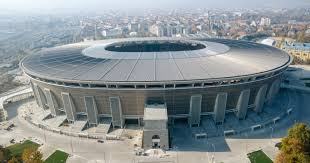Exploring the Puskás Aréna: Hungary’s Iconic Stadium

Introduction
The Puskás Aréna, located in Budapest, Hungary, stands as a testament to modern architecture and sports culture. Opened in November 2019, this state-of-the-art stadium has rapidly gained recognition as one of the premier sporting venues in Europe. Named after the legendary Hungarian footballer Ferenc Puskás, the arena not only celebrates the rich history of Hungarian football but also serves as a multi-functional venue for large-scale events, making it highly relevant in contemporary sports and entertainment.
Significance of Puskás Aréna
With a seating capacity of over 67,000, the Puskás Aréna is significant for multiple reasons. It serves as the home ground for the Hungarian national football team, hosting major international matches including qualifiers for the UEFA European Championship and the FIFA World Cup. The facility also accommodates concerts and various cultural events, further enhancing its importance as a multifunctional venue.
Architectural Highlights
The design of the Puskás Aréna showcases a blend of modern architecture and traditional aesthetics. It features an impressive façade with a distinctive curved roof and a state-of-the-art interior that meets FIFA and UEFA standards. The stadium is equipped with the latest technology, including a sophisticated lighting system and large LED screens, which contribute to an engaging spectator experience. The arena was designed by the Hungarian architectural firm, KÖZTI, reflecting both a modern outlook and homage to the legacy of Hungarian football.
Recent Events and Future Prospects
Since its inauguration, the Puskás Aréna has hosted various significant events. In 2020, it was one of the host stadiums for the UEFA Euro Championship, drawing thousands of fans from around the world. As we approach the 2024 UEFA Euro, anticipation is growing for the possibility of further major international events being held at this venue. Additionally, with Hungary’s increasing prominence in international sports, the Puskás Aréna is expected to play a central role in sporting events within the region.
Conclusion
The Puskás Aréna is more than just a stadium; it is a symbol of national pride and an essential part of Hungary’s cultural landscape. As a venue that seamlessly integrates state-of-the-art technology with the historical essence of Hungarian football, it is poised to remain at the forefront of sporting and cultural events for years to come. For sports enthusiasts and event-goers, the Puskás Aréna represents an exciting future filled with memorable experiences and a celebration of sporting excellence.


